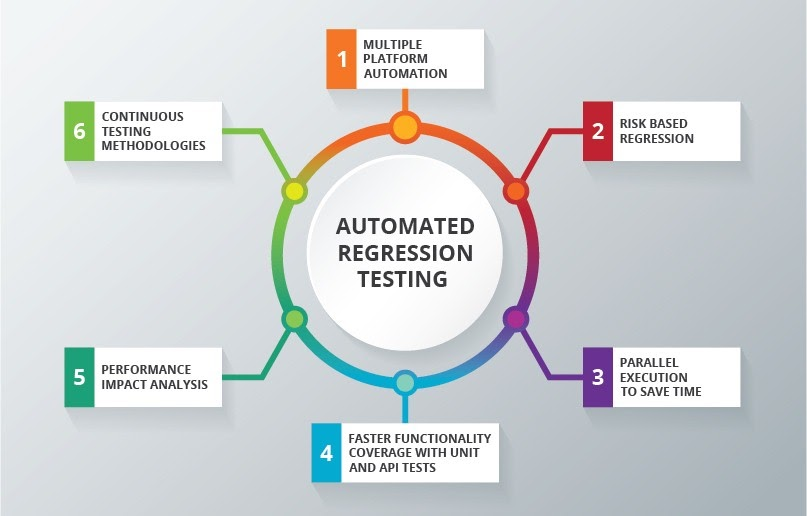The Benefits of Automated Regression Testing
Introduction to Regression Testing:
Regression testing is a process of evaluating changes to an application or system, which are made to fix issues to ensure that the changes have not inadvertently introduced new problems.
Quick Links
Regression Testing is defined as testing done to catch regressions in previously tested functionality.
“Bug fixes,” “new features added to the code,” or “changing needs” can all result in code regressions. The goal is to test all of the code affected by recent modifications to ensure that no new issues are introduced into previously tested functionality.
Regression testing is done both manually and automated. Manually regression testing has a lower cost but at the same time requires high knowledge of programming. However, software test automation is using software tools which makes it more reliable as it does not need human participation. Automated testing is a perfect option for repeatable testings such as regression, performance, and load testing.
Although many people confuse regression testing with retesting, testers should consider that the two are not the same. Regression can be done using automation tools or manual testing tools. It is feasible to achieve several desirable results that improve team agility and product quality by automating regression tests. This article will understand the benefits of using automated regression testing.
Need for Regression Testing
If you have a large regression test suite and are actively developing a product, the best advice is to automate the regression testing. This is because regression testing is the only type of testing that requires several iterations. It may be done before each release, in the form of comprehensive regression testing, or it could be done after each modification to the code in the form of partial regression testing.
Regression Testing – Importance
Regression testing has become more critical as the Agile development technique has grown popular. Many businesses nowadays use an iterative, Agile software development process. For example, with each software update, many software as a service (SaaS) companies will upgrade their features or add new capabilities to their offers. These businesses will do regression testing to guarantee that new feature additions have no impact on their core product.
Who Should Perform Automated Regression Testing?
- Testers who have not previously tested the feature can carry out the documented test cases. In such circumstances, the documentation for newcomers should be adequate.
- Testers who may not have run the functional tests but have a thorough understanding of the features that require regression testing can spot any significant flaws that may have been introduced.
- Testers who ran the functional tests for the features that need to be regression tested previously
Benefits of Automated Regression testing:
- Automated regression testing saves time, effort, and resources that would otherwise be spent on manual testing tools when the product’s codebase is large. Many test cases need to be conducted for regression testing.
- Symptoms are thoroughly covered. Every single flaw or defect can be found through regression testing. This can be accomplished if regression testing is performed for every minor change made to the software. Using techniques such as complete regression testing and retest-all regression testing, flaws that go unnoticed can be identified. As a result, regression testing covers a wide range of symptoms.
- Some test cases may be skipped when testing using manual testing tools. This could be due to a lack of familiarity with the functionality, a lack of time to complete the tasks or genuine errors. Automation ensures that no small features are overlooked.
- Manual testers may have to limit the number of test cases they run to high priority ones to save time, whereas automated test cases can be repeated multiple times, typically after each change. As a result, the quality is monitored at all times.
- There are situations when a software malfunction is extremely significant and must be addressed immediately. Automated Regression Testing helps the company make quick modifications and distribute them to its consumers.
Simply said, regression testing is advantageous since it always encourages the improvement of the software or product’s quality. It is beneficial to ensure that issues already identified and fixed do not recur. One of the key advantages is that it ensures that by introducing new modifications, the core section of the program remains unchanged, implying that the update does not affect the software’s core.
How to Use SEO and SEA Together in Search Engine Marketing
In digital marketing, search engine marketing (SEM) plays a critical role in improving online…
0 Comments10 Minutes
Content Marketing Growth Hacks: Real Shortcuts to Drive Traffic
Are you still lagging in content marketing? Sticking to these old strategies seems…
0 Comments10 Minutes
How to Build a Strong Local Following Using Social Media Marketing
In the days of likes, shares, and stories, local businesses have a golden opportunity to create…
0 Comments9 Minutes
Why WooCommerce is the Best Choice for Your Online Store?
WooCommerce stands out as a top option for anyone looking to build an online store. This platform…
0 Comments8 Minutes
How to Use AI-Powered SEO Tools for WordPress eCommerce
SEO is a critical factor in the success of any e-commerce WordPress store. As competition…
0 Comments11 Minutes
Why Short-Form Videos Are the Future of Content Marketing
Your Instagram customers spend over 50% of their time watching short-form videos and reels. Rather…
0 Comments12 Minutes
The Role of Digital Marketing in Business Growth
Online marketing touches every aspect of a business, whether it is initiating the idea or for an…
0 Comments3 Minutes
AI Meets Authenticity: Balancing Automation and Human Touch in Content Marketing
Is your brand starting to sound like a robot? In a world where algorithms write faster than any…
0 Comments8 Minutes








